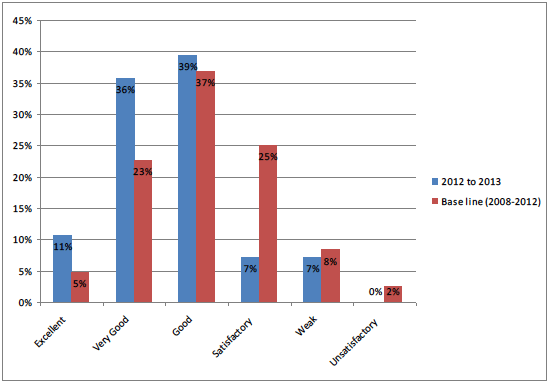Implementation of The Education (Additional Support for Learning) (Scotland) Act 2004: report to Parliament 2013
Progress report on the implementation of the Education (Additional Support for Learning) (Scotland) Act 2004 (as amended).
Education Scotland picture of support and impact on outcomes
In previous reports to Parliament it has been confirmed that consistently, overall learners needs are well met with strengths in key areas. This continues to be the picture in Scotland's schools throughout 2012. There has been a marked improvement in the performance of special and independent residential schools over the last 5 years, as evidenced below.
Overall, inspection reports over the past five years show that special schools in Scotland are continuing to improve. HM inspectors, Education Scotland, inspected 112 special schools between May 2008 and November 2013. During this period, the table below shows that 84% of schools met the National Performance Framework ( NPF) criteria by achieving a positive inspection report (satisfactory or better evaluations). Of these schools, over a quarter were evaluated as very good or excellent and 16% did not meet the NPF criteria.
NPF results for special schools between May 2008 and November 2013
| Satisfactory or above | Good or above | Very good or above | Did not meet NPF criteria |
|---|---|---|---|
| 94 | 59 | 29 | 18 |
| 84% | 53% | 26% | 16% |
Evaluating progress over time in day special and residential special schools
Due to the smaller number of inspections in both special and residential special schools it is more helpful to look at trends by comparing quality indicator evaluations for inspections since the beginning of 2012 with the 2008-2012 baseline. Although there is still half a year's inspection data to be added to the 2012-2013 data, it is possible to look at what inspection information is saying about how well special schools are performing.
The five quality indicators relate to; 1.1 Improvements in performance, 2.1 Learners experiences, 5.3 Meeting learning needs, 5.1 the curriculum, and 5.9 Improvement through self-evaluation
Overall, comparison data shows clearly that special schools are performing well with proportionately more good and very good evaluations for all five Quality Indicators Is in the 2012-2013 period than in the 2008-2012, although there are fewer excellent evaluations. One factor which may account for a slight drop in excellent evaluations is that all special schools inspections during 2012 and 2013 had taken into account Education Scotland Advice Notes during this period. These advice notes to schools reflect developing practice and increasing national expectations of progress in the implementation of Curriculum for Excellence.
For example, the information and graph below describes the improvement in the Quality Indicator 5.3 Meeting learning needs
Between 2012-13 to date and the 2008-2012 base line 'Weak' scores have decreased by 1 percentage point. 'Satisfactory' scores have decreased notably.
This decrease is combined with an increase in 'Good', 'Very Good' and 'Excellent' scores for meeting learning needs. In residential special schools in particular, this is an improving area.

Contact
There is a problem
Thanks for your feedback